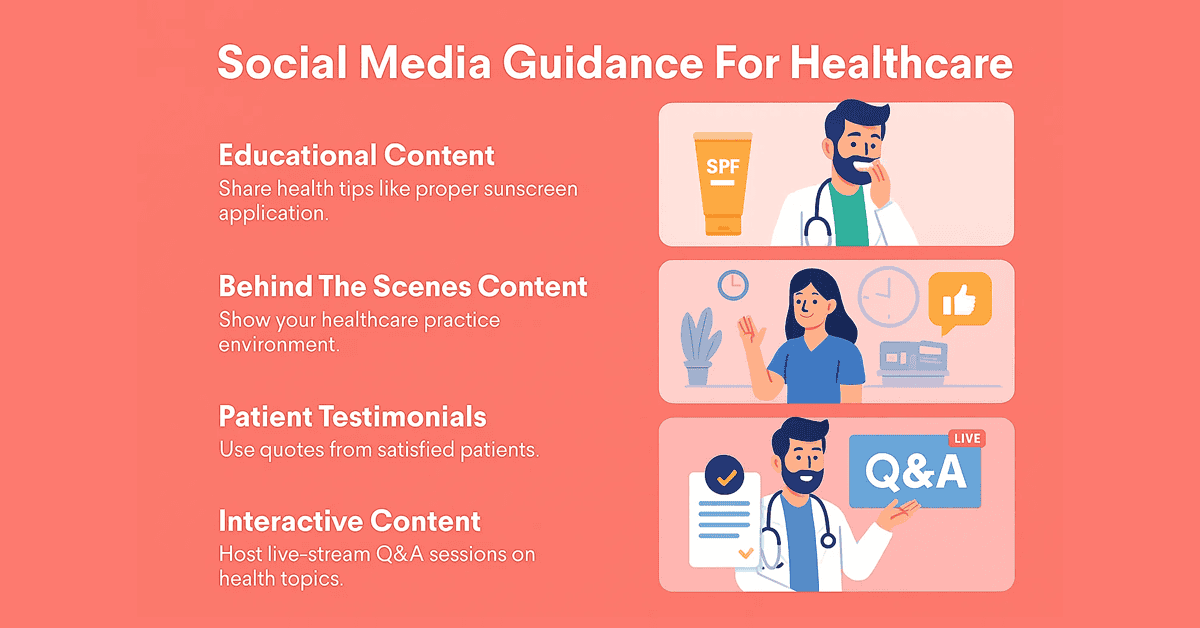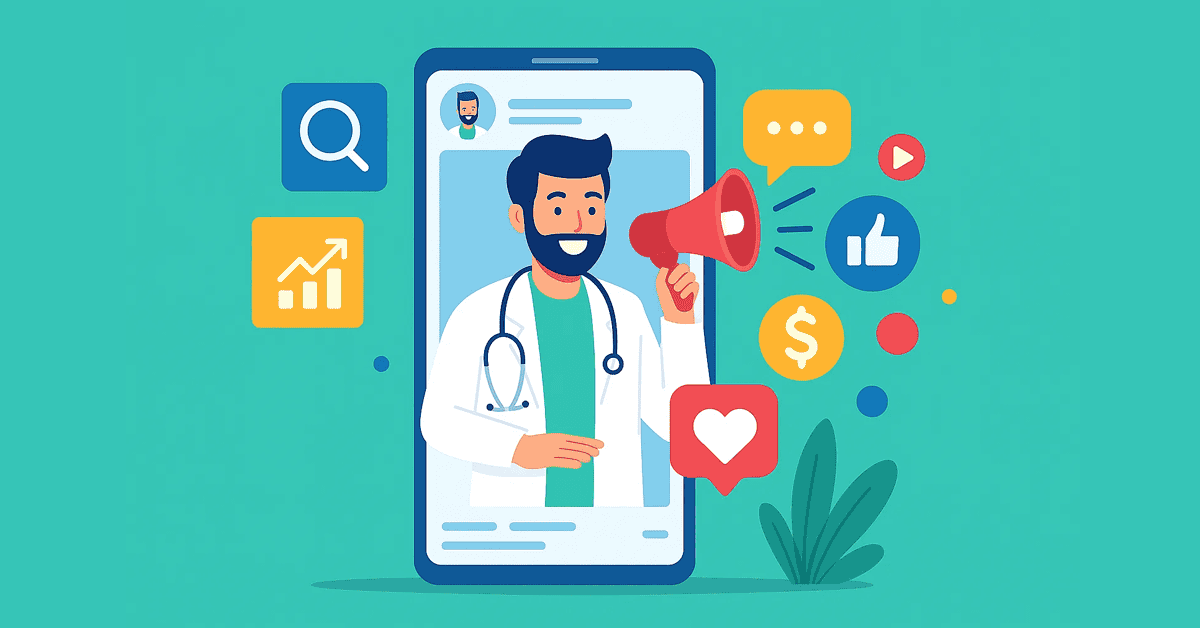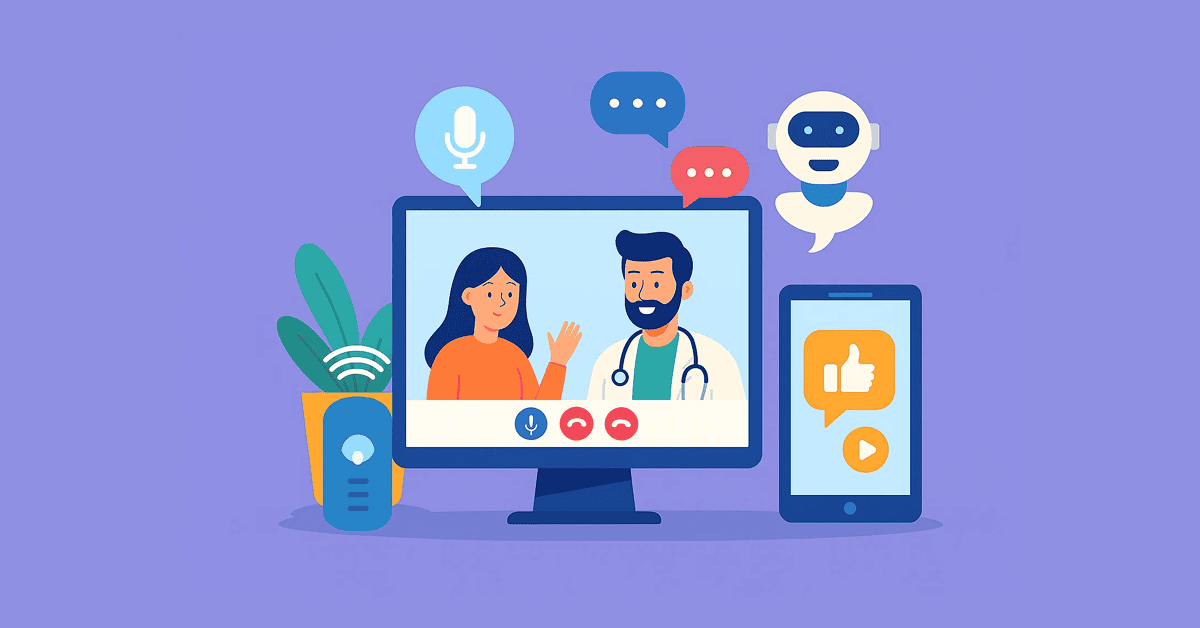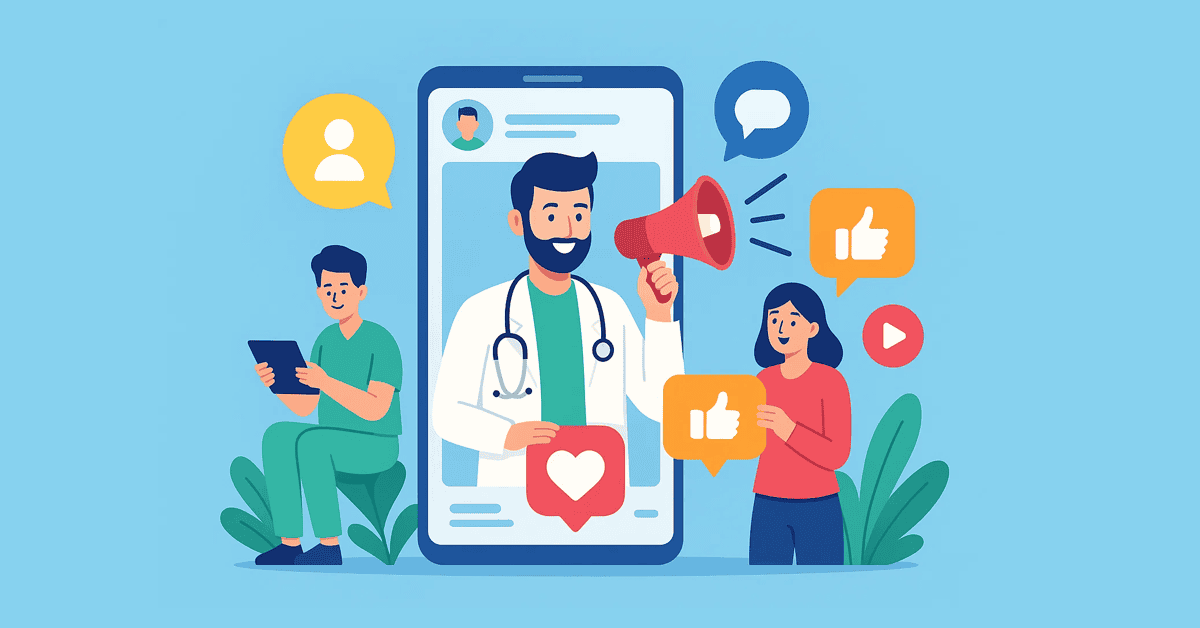When doctors hear “social media marketing,” most of them tighten up. It’s enough for them to think of influencers promoting their supplements or cats’ videos around the clock. Well if they have that opinion, they missed out on this: Social media platforms have already been daily used by 253 million Americans, and the number is expected to account for 73% of the US population in 2025.
Surprisingly, searching for healthcare information online is becoming the number one activity of the general population and the younger generation, in particular.
If you are still in the debate of whether social media is “professional enough” for your medical practice while your competitors are already making money from Facebook ads and establishing patient relationships through Instagram, you are lagging behind. The percentage of doctors are realizing that this is the new way to do business and the early adopters have already witnessed a spurt in practice growth of 40-60% within the first 12-24 months.
No, this doesn’t mean that you must have the most trending picture or to be someone the world is talking about. Rather, it’s about reaching out to those people who may want your service, letting them know how much in your care can save them, and making use of working strategies to develop your business, all the while, you remain fully HIPAA compliant.
Key Takeaways
- It has been found that 72.5% of the U.S. population from the entire country were actively using social platforms in 2025 at their disposal.
- On the one hand Facebook which started as the first choice for reaching patients aged 30 and above still is the perfect fit for this category of people but on the other, there are Instagram and TikTok which are doing better in terms of usage by patients of a younger demographic.
- Among various types of posts, educational content and patient testimonials are considered to have the highest level of engagement.
- Nothing is more important than HIPAA agreement – never talk about secret information on social media that is related to your or someone else’s health.
The road of traffic is your patient’s software, which plays the most important role in finding out social media and successful media sites for healthcare. This can significantly increase patient conversion rates.
If you post consistently with the frequency of 3 to 5 times every week and are involved in a professional manner, you will slowly but steadily see the growth of the practice. You can accomplish this by leveraging social media tools like , that use AI to help generate, schedule and publish social media posts in the voice of your brand.
Why Social Media Marketing is Essential for Medical Practices in 2025
The figures speak for themselves. Watching shifts of 253 million people on a daily basis, the internet had not only become the first stop for those who look for healthcare providers but also the place where they do research. Skin doctors or pediatricians are the examples.
They do not search for the phone book anymore–they read the reviews on Google, check their Facebook feed, and inquire, in the local community groups, about doctor referrals.
It’s a fact that a majority of healthcare marketing is digital and uses social media resources. Whereas in traditional healthcare marketing, the budget is larger, without it lacking however it now becomes more cost-effective through social media resources. The budget is also flexible in that it can cater to increases in the variety of demographic targets for example in the healthcare domain.
Furthermore, the increase of online patients was remarkable in a suburban pediatric practice in Texas which was 52% in 18 months after targeted Facebook education campaigns, parent testimonials, and a structured follow-up process for review-requests were used. Their competitors, on the other hand, still stuck to the old way of relying on printed yellow pages and word-of-mouth.
Of those two, healthcare organizations that comprehend the changeover will be those that succeed. It is of utmost importance to get a grasp of the fact that the situation has changed by early adopters as they start building relationships with potential patients before their competitors catch Sierra Leone marks in which they lead the way. The use of social media has been a frighteningly large percentage of healthcare practices.
Social media has opened up new paths for doctors to connect with their target audience, directly in ways that traditional advertising did not allow. By using the platform, healthcare professionals can communicate with patients, respond to their queries, give healthcare advice, and gain confidence while at the same time they exhibit their expertise and personality. This personal relationship has a significant impact not only in healthcare but also in building trust, which is of paramount importance in that particular field.
Which Social Media Platforms Suit Your Medical Practice the Best
All social media channels do not perform healthcare professionals well. Each of them has its group of people. You can find out the direct link to various demographics and at the same time the role it plays in the overall social media marketing strategy and narrow your choices further.
Healthcare marketing is dominated by Facebook, and this has good grounds. The platform hosted 69% of U.S. adults, proving it still rules the roost in patient acquisition for practices dealing with patients who crossed their 30s.
By the way, local marketing comes as a result of the platform’s strength in this area, excellent for practices which cater to a certain, smaller area. Available advertising on Facebook is such that one can break down his or her targets further – by location, age, interests, and even health-related deeds.
Facebook is, in addition, a platform that paves the way for long-form educational content, patient community building, and detailed practice updates. Its communication tool is beneficial for the patients or leads that have questions regarding the practice and would like to book an appointment straight away.
Instagram has the ability to draw a youthful audience ignored by Facebook. The platform is the must-have visual solution that helps to reach patients under 30 and portrays the human side of the practice. Instagram Stories and Reels obtain increased visibility in the algorithm, hence they can be used as background material, fast healthcare tips, and debunking medical misunderstandings.
The increase in consult requests among 18-35 years old is positively contributed by Instagram Reels of a dental group in California. Also it was acknowledged that working with local fitness influencers brings direct referral traffic which is proven by unique booking links in bios that Instagram provides.
LinkedIn in the industry of healthcare professionals platforms functions as a way of professional networking and not to acquire direct patient leads. At first, you can use LinkedIn to collaborate with other healthcare providers in building relationships, become a thought leader in your niche, and make your referral network. In particular, specialists and academic physicians benefit greatly from LinkedIn as they use it for professional development and making mutual referrals.
Health education content is at the edge of availability through TikTok. It is yet to fully emerge in healthcare marketing, but medics who can make genuine educational videos on TikTok are quite likely to have their content reach a wider audience especially young adult patients. Then it will seem like the information that is being passed is only from the angle of educating people and not exactly to market a business or idea.
The break-up of a budget of a practice can come in different ways depending on the type of practice, however, a majority of the funds may be spent on the digitization of the records. The monetary divisions could be Facebook/Instagram advertising to 60%, content creation to 20%, review management tools to 10%, and LinkedIn networking for referral-based specialties to 10% of the total budget.
Content Strategy That Converts Social Media Followers into Patients

You have to start with a clear understanding that success in social media for healthcare is possible if you are a reliable source of health information meaning you should be guiding 80% with educational content and then you can start to promote 20% of the time. The point is to not ask for anything in return before giving. This strategy allows for the establishment of trust and communication of the health domain in a credible way.
Sharing preventive care guides of common sickness, treatment process explanation, breaking myths on the ailments, and extending personalized health tips for a specific situation makes educational content your expertise, besides adding value to your audience. For instance, a dermatologist could enlighten the public on the correct way to apply sunscreen, whereas a pediatrician might provide information about managing kids’ fevers.
Behind-the-scenes content is what gives your practice a human touch and basically serves as a basis for emotional bonds. The idea here is you bring out your staff, display the infrastructural improvements you have done, or how a typical day runs at the practice. The essence of people that are giving you care must be revealed to the public, so that prospective patients get more convinced to choose your practice through this content.
Patient testimonials and success stories are a powerful tool for social proof, and additionally, they can drive conversions if done in a proper way. This is essential because you do not want anyone to disclose any of their patient’s private confidential information and make them your main focus. Traditionally, the former through the proper handling of the patient could narrate such as ‘the patient’s problem had been completely solved due to the good treatment of the doctor’ to spearhead the same purpose.
Interactive content helps your audience engage and also sends a signal to social media algorithms that you are an expert in that particular niche. It is a good idea to have polls such as “What health topics do you want to learn about?” or Q and A presentations where the host can respond to general health questions. Live streams using platforms like Facebook or Instagram are more effective when a doctor needs to explain some procedures or talk about matters that cause uncertainty to patients.
Planning your content is not something that should be taken lightly since running out of themes to post one of the days may kill the flow. Come up with a content calendar, and your target in a week should be 3-5 posts, which is actually a good number of posts per week. Automation of your postings and using a tool similar to will help you achieve all these without any hassle and at the same time save you time as a busy medical professional.
Never forget that every content piece should either inform, or build trust or subtly guide the customer in scheduling a meeting. Avoid the use of aggressive sales tactics that drive away potential patients. Rather, create content that is both informative and interesting so that people naturally look at you as the best healthcare provider for them.
Facebook for Doctor’s Marketing
When it comes to healthcare, Facebook is still the king of marketing platforms, as you will be able to talk to the most significant number of adults who are active on social media and who also seek health-related information. According to the way you employ it, your time and money can be either saved or wasted in the marketing process.
Make a Facebook Business Page that is perfectly optimized from the beginning and that has your full practice information: address, phone number, hours, services, and a unique practice profile. In addition, it is highly recommended to have some images of your facility, staff, and any awards or certificates you may have. This is a strategy that not only very much improves your page’s SEO but also makes it easy for your patients to locate and get in touch with you.
Healthcare providers are given almost infinite targeting options in Facebook ads. They can specify the location (useful for those who are in the same locality), age, interests, and behaviors of the people. A general practitioner can zero in on parents of kids aged 8-20; these parents are likely to live within a range of 5 miles and share their health and wellness interests.
Similarly, a plastic surgeon could reach out to those in the locality who are of the age of 30-60 and are interested in beauty and wellness.
Creating individual landing pages for each service as a practice of optimizing conversions from Facebook ad campaigns. The idea is to guide the user to a web page that is exclusively about “annual physicals” or “pediatric care” where there are available and clear options for booking appointments instead of sending them to the home page. This customized approach is observed to be capable of getting the rate of conversion double or even triple when contrasted with the usually website visitor flow.
Facebook Insights and Meta Business Suite are two tools that offer a lot of data about campaign performance. Information such as cost-per-click, conversion rates, and patient acquisition costs are the main metrics you need to monitor. The most profitable healthcare actors in the market usually spend around $10 to $20 daily, for campaigns with a local focus, although the situation may vary from one field to another and from market to market.
Testing and improving are the two components of success on Facebook. The most efficient techniques of testing are those using statistical significance. Use A/B tests in different categories: ad headlines, images, posting timing, ad copy, etc.
Show buttons such as one that says “Book Now” versus another which has “More” written on it, or show the same topic using completely different ways to educate your audience. With these data behind bars, practically, you will not throw away your entire budget.
Instagram Marketing for Healthcare Providers
Instagram is a picture-based platform that connects with the human side of healthcare and at the same time, works as a channel for engaging content that forms a trustful relationship with potential patients. The fact that the age profile of the users on this platform is on the lower side, means that your audience will be skewed to an audience who prefers real and unfiltered content over polished advertisements.
Visual content can hay to the greatest extent effect if the educational part is spiced up with a sense of humor. Posterization is a good combination of techniques that provided the desired result. Share infographics that explain the most common conditions, talk about the treatment regimens etc.
You can also display photo transformation, (but with the necessary accords), and create educational carousels by breaking down the complex health for the better understanding of the people. The cardiothoracic surgeon in this case will share with the public well-balanced food recipes and on the other hand, a dermatologist would give advice on the daily skincare routine.
The Instagram algorithm favors Stories and Reels, so it is crucial for reaching out not only to the masses, but also to your local audience. You can apply a multitude of different things to the Stories feature – from quick health tips, and staff spotlights to “day in the life” content that gives your practice a more lively and welcoming character. Reels are great for conveying educational content, procedure explanations, patient FAQs directly and quickly and even cover more than one in 60 seconds.
Hashtag use can bring new patients to the content you put out. Identify healthcare hashtags like #healthtips, #preventivecare, #wellness, and those with a geography or location-based scope like #denverdermatologist or #austinpediatrics. To target both wide and specific audience segments, try a mix of popular and niche hashtags.
Teamwork with local health influencers and community organizations can scale your reach notably. Align your interests with fitness trainers, nutritionists, or wellness coaches to achieve a win-win cross-promotion situation. A physical therapy practice could team up with nearby gyms, and, and together, share workout tips that naturally, through the same channels, lead to sports injury referral.
Healthcare entities are able to use Instagram Shopping features for selling, directly on the platform, health products, supplements, or wellness services. Yes, not all clinics and practices would fancy the feature, nevertheless, it can be the lot of skincare products, personal care staples, or wellness program centers.
HIPAA Compliance and Privacy Considerations
Compliance with HIPAA is not an option but a must. A single violation can lead to a fine of hundreds of thousands up to millions of dollars, and more importantly, your practice will suffer irreversible reputation damage. If you know the rules, you protect not only your patients but your practice as well.
One essential rule is that the patient’s photo or his/her details cannot be shown without a specific, documented written consent. This also includes images that display faces of the patients, test results, appointment details, or anything that could lead to a patient’s identification. Even a post like “Mrs.
Smith had a good visit today” if showing someone received medical care is HIPAA- infringing.
Patient consent forms, which are particularly designed for sharing patient stories or photos on the internet (e.g., social media), are indispensable. They should be different from general treatment consents and expressly spell out how their information will be shared on digital platforms. Keep all the signed consent forms safely and only post patient content with this documentation.
Educate all employees in contact with the company’s media on how to communicate following HIPAA rules. They should understand the difference between general health education (“5 warning signs of diabetes”) and anything referencing specific patients or situations. Set strong guidelines about who has access to posting and how contact with patients received through the social media platforms should be handled.
We strongly advise against providing patients with medicines or treatments through your existing social media channels. In the event that a patient comments or sends a message with a question of a medical nature, give a professional response, for example, the one that assures them to schedule an appointment or contact your office via the secured channels. Just telling the person, “Thank you for the question! For a personalized diagnosis of your medical issue, kindly give us a call so that we can book an appointment for you” is both complaint and helpful as well.
Attach a privacy policy that is social media-specific to all your practice accounts. The policy should detail what patients should anticipate when using your social media, the limits on communication, and the cases when you will not answer publicly (for instance in the case of a medical emergency that requires immediate attention).
Pharma Marketing in the Digital Age

Pharma has only recently begun to tap into the power of digital marketing which has been utilized by virtually every other sector for years. E-detailing or remote detailing, for example, is a service that is a product presentation and is done online or electronically. This is just one of the Surprising Benefits Of SaaS (Other Than Lower Costs) that can be utilized in the pharmaceutical industry to improve the doctor-patient experience while lowering costs.
Campaign objectives could either run parallel with your practice objectives or be tailored to meet those objectives. Brand awareness campaigns are ideal for new practices or existing practices that are expanding their service areas. Lead generation campaigns would only be targeting customer contact details from those that were interested.
Appointment booking campaigns focus on direct conversions, so do patient education campaigns, but the latter is about building and nurturing trust via education.
Demographic targeting is an important part of your specialty’s marketing strategy. A pediatric practice, for example, may target parents predominantly aged 25-40 within a certain distance, and a plastic surgeon might target adults aged 35+ who show an interest in beauty and wellness. The demographic of orthopedic practices is usually active people who have an interest in sports and fitness.
Therefore, it is of utmost importance to understand your ideal patient population and to describe them in a way that matches their demographic.
A/B testing is an effective way to find the right mix and improve the performance of ads. That is, you can compare the performance of “Same-Day Appointments Available” headline against “Accepting New Patients,” or you can use different images such as presenting your facility, staff, or educational content. The “Book Now” call-to-action button, therefore, is said to outperform “Learn More” when it comes to direct appointment scheduling.
Initial budget optimization for the first time is a matter of small proportions and is realized only through positive results. The majority of medical practices are familiar with the concept of ad testing where they initially invest a monthly sum of $300-$600 to gain a good understanding of their potential clients through the variety of advertising campaigns and target audiences data. Reusing famous campaigns and the creation of new markets which will be the resource engine to the old ones are performed well through a new constructive finance strategy.
Quick and wide growth of the business refers to examples such as this one where a product is improved by the people who already supported it. The limited growth of the business should be used to control the saturation of the product market and to keep the existing customers back. At the end of the process the public and the company are in a situation to create a certain amount of value only if the number of customers and purchases remain the same.
One way of handling problems is the possibility of finding articles that address your mistakes and offer solutions. This can be seen as a sign of unethical practice in relation to the customers who are not aware of the modifications that have occurred or even those who have knowledge and still do not condone the changes. That deals with cheating whether it is in the traditional or electronic business setup and left it to ethical conscience to deal with the opportunity or danger that the fraudsters and hackers might prepare for the future.
Conversion tracking requires the setup of Meta Pixel and the integration of Google Analytics. The first thing to do in the process is to implement pixel tracking. The complete way patients undergo should be monitored from the time a call to action is presented on a social media ad to the moment an appointment is made.
Thus it becomes necessary to have a piece of accurate knowledge about the result of the investment and decide on future advertising projects.
All things considered, the key performance points in the healthcare industry are the processes cost-per-click, conversion rates, and patient acquisition costs. Some of the things that matter are knowing each of the elements and the methods that increase their interconnectedness and make each other better monthly and keeping up with changes in the traditional marketing channels. Most health organizations are of the opinion that social media is instrumental in reducing the number of people accessing the expensive print, broadcasting, and community advertising channels, while still delivering similar and higher numbers of patients.
Building a Professional Network and Referral Relationships
Networking for healthcare professionals the most valuable platform on LinkedIn means that many connections may lead to a lot of referrals for business. Thus a connection with other similar companies can be rewarding because they are the ones who include your target market. It is better to have a connection with several health.
Practitioners in the same region and areas of specialty rather than having a superficial connection with many people. When you need to tell a person(s) ‘it is not longer necessary to perform a certain task for us’, what can best work?.
Connect to your professional circle like-minded health professionals via a platform such as LinkedIn. One can send an invitation to be part of the.
Sharing medical content strategies make your status rise higher in the medical world. Share related medical researches, comment on industry news, or even write solutions about advances in your niche. This visibility makes you the first to be called when colleagues have to refer patients with your specific needs.
Localise medical forums and professional groups on social media networks. Means that you should join LinkedIn groups so you will have more chances to get information on your subject, have discussions, and share your knowledge. Facebook groups for local healthcare providers have networking functions and also, they do referrals of the patients easily between practices.
Professional development content gives an impression of your ongoing commitment to stay updated in your area. Tell about the conferences you were present at, the courses you took for the continuing education, or the new techniques you’ve learned. It brings the trust of referring doctors and potential patients as well.
When you become part of the conference industry network, it is better if your connection with new people is not only limited to personal interactions. Connection carried out via social media always taps into when people follow up with their partners on LinkedIn, share the information with their colleagues that they mostly heard of, and are more than willing to continue with dialogues initiated during the conference. These kinds of relationships always lead to the most productive referral partnerships.
Measuring Success: Analytics and Performance Tracking
![]()
With analytics tools, you will not just have data but also the power to optimize your social media marketing efforts and convince the practice stakeholders that the investment brings good results. Marketing without proper measurement is similar to marketing blindfolded without the ability to see what works and what consumes your money.
Engagement rates (likes, comments, shares per follower), particularly those within your geographic service area, follower growth, website referral traffic from social media platforms, and most importantly, new patient appointment bookings are the four key performance indicators for medical practices.
Meta Insights, Google Analytics, Hootsuite, and Sprout Social are social media analytics tools that can offer you different insights into your social media performance. The platform-specific engagement and reach data can be seen on Meta Insights. Google Analytics, in this case, lets you see how social traffic performs on your website.
Meanwhile, third-party tools like Hootsuite allow you to carry out consolidated reporting for multiple social media accounts.
The monthly reports and layouts play a role in keeping the progress of the activities throughout and help to figure out any patterns over time. Design a report format where you can show follower growth, engagement metrics, website traffic from social sources, and appointment bookings caused by social media campaigns. This regularity makes it easier to see which measures are successful and which ones need to be adjusted.
Calculating the patient acquisition cost for social media campaigns requires you to track the whole patient journey. Use UTM parameters in your social media links that are connected to referral traffic in Google Analytics. Keep track of the posts and ads that are responsible for the most website visits, contact form submissions, and real appointment bookings.
By analyzing the conversion funnel, you can identify the exact point at which potential customers are lost between the social media awareness phase and the appointment booking phase. If social ads generate many clicks but few appointments are made, you might have to work on your website optimization part. Besides, if a post has a high engagement yet low website traffic, a reason could be that your call-to-action lacks persuasiveness.
Competitive analysis techniques are the best way to evaluate your performance in comparison with other local practices. Keep track of competitors’ social media activity, engagement rates, and content strategies. Social Blade and similar tools are great for getting the follower growth statistics of public accounts which can help you figure out your market position among competitors.
The Bad Practices of Social Media Marketing
Healthcare practices with the best intentions are still prone to making social media blunders that can seriously mar their reputation and squander their marketing budget. The knowledge from these typical mistakes empowers you to avoid costly mistakes while you are building your online presence…
The biggest mistake many medical practices are still making on social media is excessive marketing. Continually talking about services, promotions, or “book now” messages will scare the audience away more than anything else. The 80/20 rule will help you in this regard: 80% of the content should be educational, while 20% should be promotional.
Without giving value to your audience, they will not consider your services.
Nothing kills your credibility – and subsequently, your reach – like changes in the posting schedules; therefore, you cannot underestimate the continuity of the scheduled posts. A hospital’s website with no new content for several months may be viewed as either of two scenarios: the place is closed or offline. is a great tool to automate posting during those days you are not present on social media.
Patients’ problems with medical service providers often come from misunderstandings, sometimes even rude or less than professional behavior. When a patient went to social media to complain, their anger and frustrations multiplied because of not being addressed, which, in return, made your practice look even worse. Never ignore any feedback, and be sure to be polite and friendly when you respond.
Publicly address their concerns when needed, while you can always hold more private discussions to protect patients’ personal information.
By sharing unverified medical info or health-related viewpoints supported by controversial means you not only risk losing your credibility but may also become a legal target. It is better to confine yourself to medical knowledge that is generally acknowledged and stay neutral on issues that are unhealthy unless they have a direct reference to your practice.
Mixing the use of personal social media with professional purposes surely upsets the categorized concerns between your private life and your medical career. It is ideal to have separate professional and personal accounts for your practice and keep personal opinions, photos, and activities on personal accounts.
Being late with replies to comments and messages on social media will exasperate potential patients and will make them think you offer poor customer service. Try to send replies to all social media interactions within 24-48 hours. Set up notifications so you can be aware of any crucial messages, and if convenient, use automated responses for common questions.
Managing Online Reputation and Patient Reviews
Nowadays, online reputation is the bread and butter of modern medical practices. A single negative review could lead to dozens of potential patients being put off, whereas positive reviews can do miracles by influencing patient decisions in favor of the practice and lifting local SEO rankings.
Encouraging satisfied patients to write reviews is a simple way to create a strong base of positive feedback. After the appointments, kindly ask happy patients to share their views online through follow-up emails. Make the process less hassle by giving them direct links to your Google Business Profile, Facebook page, or other review platforms.
Review monitoring tools and notification systems alert you in real-time to new reviews coming up on platforms from various vendors. Through Google Alerts, Reputation.com, and other tools, there are services that let you receive a notification the moment your profession is mentioned on the web, hence giving you the time to reply to both the good and bad feedback promptly.
Professional response templates do not only help to maintain a consistent and compliant tone when responding to patient reviews but also assist in saving time for the busy professionals. To this end, it is advisable to have models for typical situations such as sending thank-you emails to patients, addressing minor complaints and dealing with issues of high concern. Communication should always follow HIPAA rules as well as never disclosing the patients’ specific health details in public responses.
Transforming bad feedback into good ones shows a high level of patient-centeredness, and this is a clear sign of the prioritization of the patient’s needs in the healthcare setting. Empathy should be the key to your reply to a patient’s grievances, where you should show understanding of the patient’s feelings and invite them to carry out the rest of the conversation in private. Professionals’ response to this approach is always positive and, in some cases, the patients even make optimistic changes to their reviews.
The presence of review generation systems in the process of following up on your patients not only guarantees that positive reviews naturally increase in number but also ensures that the process gets streamlined. Staff training could include a request for a review on the way out, a review request as well as an appointment reminder, and lastly a request to visitors to your site. On each of these, you can also say “thank you for choosing Our Clinic.”.
Another aspect to keep in mind when responding to reviews is your reviews being leaked accidentally, which may become a legal issue. For instance, to avoid any violation of HIPAA rules, never acknowledge a patient, give any specifics about treatments, or reveal any medical information. Your answers should be straightforward, client-centered, and centered mainly on the aspect of your quality care guarantee.
Future Trends in Healthcare Social Media Marketing

Communities on social media sites change continuously. Staying in touch with the moving times would help healthcare practices stay ahead of the game. Recognizing the up-and-coming technologies and getting the hang of the platform changes is what you need for alterations in your social media strategy before others take over.
AI and chatbots are transforming the provision of patient care on social media. The chatbots that use AI technology are very efficient in a clinic to a patient manner. They can help a person to get an appointment, answer the general questions and also give the necessary basic practice information.
This technology not only spares the staff’s time but also provides instant replies to the client’s requests.
In the majority of cases, video content remains the most adapted to on social media platforms’ algorithms. Live streams explaining surgeries, online classes to the patients, Q&As sessions from the patients, and webinars in real time get more public involvement than public posts. Get some basic video equipment and learn some editing skills so you can be a part of the change.
New platforms such as TikTok, Clubhouse, and YouTube Shorts are great for healthcare practices who like to be early adopters. These platforms usually bring newcomers more organic outreach for free thus, medical practices can create an audience from scratch without having to spend a lot on advertising.
Integration of telemedicine and social media allows patients to manage their health electronically. Some platforms offer direct booking of appointments and virtual visits, with a simple click through social media. The integration leads to better patient care as it takes cooperation with a patient to initiate daily use.
Voice search optimization is that thing that makes patients know the majority of healthcare professionals through social media. Simple and straightforward should be the profiles and content that you upload to the social media platform, and they should articulate the case in a voice search such as “find a pediatrician near me” or “dermatologist open today”. Besides, you should only incorporate the keywords that are frequently used in natural language and your exact location as well.
Changes in the algorithm have pushed the boundary between authentic and promotional posts further towards authentic and engaging. Therefore, more and more platforms are promoting posts that have led to real conversations and engaged public participation. The main idea is to create discussion-oriented content that not only invites comments but also shares and other interactions that are significant rather and more than just passive consumption.
Accepting platform features first gives the users an edge over competitors in terms of time. Some of the brand new marketing approaches in the health sector are due to Instagram Shopping, Facebook Groups targeting chronic disease, LinkedIn Newsletters, and the business features of Tiktok. Being updated with the platform is vital.
Final Thoughts on Social Media Marketing for Doctors
The change in the age of patients from the analog age to the digital era has been accompanied by essential differences in the way patients find and choose healthcare providers. For doctors, social media marketing is not just another marketing strategy; it’s a tool for practice growth and patient engagement. The healthcare practitioners who are first adopters of these strategies are assured of building a competitive edge that would be insurmountable, to say the least.
Being successful in this field means being patient, being consistent, and putting value ahead through your social media channels. Educate the community, establish sincere connections with the people following you, and most importantly, ensure that you always comply with HIPAA. Those doctors who have mastered social media marketing will be able to not only thrive but also become irresistible heroes in their local markets.
Today it is not a question of whether you should start social media marketing or not—social media marketing is the only necessity that can lead you to success. The good thing is that your potential patients are currently online searching for healthcare providers and not only that, but they are also asking for advice as well. In order not to be missing on all these potential patients, it is your responsibility to ensure that they find you first.
FAQ
What is the budget a doctor should have for social media marketing by 2025?
Start with a monthly advertising budget of $300-600, in addition to the time or the staff costs for content creation. For the ad budget, many win-win practices allocate between $10 and $20 in Facebook or Instagram ads per day as the initial stage and increase the budget based on the outcome. Content creating tools and scheduling platforms require $50-200 per month based on your needs.
What kind of patient photos can be shared on social media and to stay HIPAA compliant?
Photos of patients should be shared only if the written consent is explicit and used for that type of media. Only consent allows the exposure of faces or any identifying marks. Non-identifying images (like hands during a procedure) are also group activities, office environments, and the options as well, hence in written policies your decisions need to be guided.
What is the most suitable frequency for medical practices to share their content on Facebook and Instagram if they want to get the best engagement?
Post 3-5 times per week on different platforms to achieve the best results. It is the regularity of the posts that matters most, rather than the frequency, as regular posting will not only increase the audience’s expectations but also positively reflect the algorithm performance. Using tools like to schedule posts can help you in maintaining consistency even in your busiest days.
Are doctors allowed to answer medical questions from their patients in social media platforms?
Absolutely not! Social media should not be used as a tool to give specific medical advice to any patient. One has to respond to the patient by informing them of the respective appointment or advise them to contact the clinic through secure channels. It is one simple way that blends compliance and helpfulness in the response that reads, “Thank you for your inquiry! For further details on your specific medical condition, you may call us to arrange a visit.”
Which are the opportune days to publish healthcare content for the highest patient engagement?
Short of sleep, early mornings with lighting green and late afternoons seeing no stoplight can guarantee the best engagement of all times at Mondays, Tuesdays, Wednesdays, and Thursdays. Nonetheless, it should be noted that the best days and times to undertake tests are with the specific audience as this method has yielded different effects according to age groups and location. With the help of analytics tools, you can figure out when your followers are most engaged.
What is the best way to deal with negative patient reviews on social media professionally?
Be efficient and professional in your response without exposing personal patient information. Validate their complaints, express regret for their sour encounter, and propose a private dialogue to speak about this in details. The idea is to handle the issue in an open, yet calm and supportive manner.
What are the best social media management applications suitable for medical practitioners who are busy?
Healthcare practitioners frequently cite , Hootsuite, Sprout Social, and SocialBee as their preferred social media tools. These platforms besides the basic options of social media scheduling and social media monitoring also allow you to get laid back statistics. The main principle in the choice process can be your budget, and the knowledge you already have.
How are doctors able to calculate the return on investment (ROI) of their social media marketing efforts?
By tracking, for example, the new patient appointments that come from social media sources and using specific phone numbers, UTM tracking codes, and patient intake forms asking how they found the center. To figure out the cost of acquiring a new patient, you should divide the total expense of social media marketing by the number of new patients. Do a comparative analysis of these expenditures with respect to traditional channels for the determination of the ROI.










